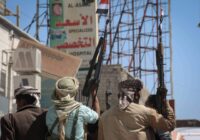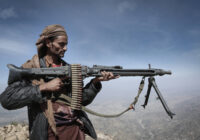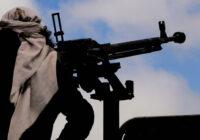Finding a political settlement that is mutually agreeable to most of the stakeholders in Yemen will be a critical part of any potential post-civil war settlement.
While many observers of the conflict in Yemen have focused on the external interventions of the Saudi-led coalition and Iran, this preoccupation with the drama of the Saudi-Iranian proxy conflict neglects the localized dynamics that led to the outbreak of the conflict in the first place — and which will ultimately decide the outcome. Even when the intervention does end, a second challenge remains largely unaddressed: how to get the major Yemeni stakeholders, whose buy-in is vital, to agree on the future national government.
The focus on third-party intervention is not without good reason, since it has been an important driver of the on-the-ground dynamics and has generated much of the war’s devastation. When the war began in September 2014, Houthi rebels took over the capital Sanaa. The conflict could have ended in March 2015, when President Abdrabbuh Mansour Hadi fled Yemen as Houthi fighters marched into Aden. Instead, Saudi Arabia led a coalition of 10 Arab countries in an air-and-ground campaign to push the Houthis back towards Sanaa. After more than three years of fighting, the war has left over 10,000 dead and millions in need of humanitarian aid. The coalition’s ongoing siege of the vital port city of Hodeidah is killing civilians and could endanger the country’s imports of food and humanitarian aid.
The seeds of this dissatisfaction and conflict can be seen in the hastily negotiated unification agreement of 1990. The accord left many southern Yemenis with unaddressed grievances about representation and the distribution of state resources. Increasing mistrust between northern and southern elites, compounded by economic turmoil after the United States cut aid in response to Yemen’s support for Iraq during the Gulf War, led to the 1994 civil war during which southern leaders attempted to secede. This effort was not successful, and southern grievances remained largely unaddressed.
In May 2007, these unresolved grievances led to an eruption of mass demonstrations across the south and created a movement known as Hiraak, or the Southern Movement, a loose coalition of southern groups that favor secession. In 2015 militias associated with the southern secessionist movement mobilized to fight the northern Houthis and assisted in driving them out of Aden.
Barriers to Peace
From the 1994 civil war to the National Dialogue Conference (NDC), recent history has demonstrated that dissatisfied Yemeni factions are more than willing to engage in costly fighting when they feel marginalized from the central government. Finding a political settlement that is mutually agreeable to most of the Yemeni stakeholders, including the Hiraak southern separatists, Houthi forces and other Yemeni actors, will be a critical part of any potential post-civil war settlement. The interests and grievances of these and other Yemeni actors remain a key barrier to lasting peace.
To create a sustainable peace, any agreement cannot merely be reached amongst Yemeni elites and outside powers, but must address the grievances of the Hiraak movement and other local actors. The failure of the National Dialogue Conference, which began when President Ali Abdullah Saleh was forced to step down during the Arab Spring and concluded in January 2014, illustrates the challenge of getting Yemen’s warring stakeholders, including the loose coalition of southern separatist groups, to agree on how the country should be governed.
As the Arab Spring swept across the region, protests broke out in Sanaa, Aden and other Yemeni cities in 2011. After government forces engaged in a violent crackdown on protesters, the Gulf Cooperation Council — backed by the United States, the European Union and the United Nations — brokered an agreement whereby Saleh would step down, and his vice president, Abdrabbuh Mansour Hadi, would become interim president. In the meantime, the NDC would make recommendations for constitutional reform and plan a political transition. However, the conference delegates struggled to come up with meaningful recommendations. Though the NDC included delegates of marginalized groups, delegations were composed primarily of Yemen’s established elites and lacked grassroots buy-in. Amid this stalemate, Houthi forces, in alliance with elements of the military that still supported Saleh, seized Sanaa, setting off the current fighting.
The NDC was lauded at the time by US officials and others as a model for Arab Spring political transitions. However, the two-year transition period ended without a new constitution and with no date set for elections. Thus, even when key members of the international community gave their full support to the transition process, it proved impossible to produce a political transition plan that could prevent the major stakeholders from defecting. With key international actors now so divided over Yemen’s fate, the challenge in a future national dialogue process will be even greater. Peace talks organized by the UN in Geneva earlier this month collapsed after the Houthis refused to attend, claiming that the UN had failed to guarantee their delegation’s return to Yemen. The failure of the talks will likely lead to further escalation.
International Pressure
International actors can play an important role in encouraging efforts toward a ceasefire and eventual reconciliation amongst the critical stakeholders in Yemen. Since the United States provides combat support to the Saudi-led coalition, which includes aerial refueling, maintenance and intelligence, it can work to persuade the Saudis and Emiratis to pressure their Yemeni proxies to participate in UN-brokered ceasefire negotiations, which could build confidence toward a more comprehensive peace agreement.
US combat support could serve as a crucial source of leverage for such pressure, but international actors must also ensure that the Southern Transition Council (STC) and other representatives of the southern movement are included in these negotiations. The United Arab Emirates in particular has invested extensively in the south and trained troops in the region. The Emirati government is therefore well placed to support a southern delegation and ensure that they’re represented in any UN-led talks.
The war in Yemen has produced strange bedfellows. In theory, the conflict is being fought between two loosely affiliated factions. On the one side are the Houthis and whatever remains of Saleh’s supporters supported by Iran; on the other, President Hadi’s coalition, which includes STC, supported by the Saudi-led intervention. These fragile alliances of convenience are held together by the logic that the enemy of my enemy is my friend, at least for now.
In reality, however, as Peter Salisbury has described it, Yemen is a “chaos state,” more like “a region of mini-states at varying degrees of war with one another” than a unified, sovereign state. Any political settlement to the civil war in Yemen that does not take into account the voices of these local actors is unlikely to succeed in creating a functional central government and a long-term peace in Yemen after outside forces have withdrawn.
*[Young Professionals in Foreign Policy is a partner organization of Fair Observer.]
The views expressed in this article are the author’s own and do not necessarily reflect Fair Observer’s editorial policy.
Support Fair Observer
We rely on your support for our independence, diversity and quality.
For more than 10 years, Fair Observer has been free, fair and independent. No billionaire owns us, no advertisers control us. We are a reader-supported nonprofit. Unlike many other publications, we keep our content free for readers regardless of where they live or whether they can afford to pay. We have no paywalls and no ads.
In the post-truth era of fake news, echo chambers and filter bubbles, we publish a plurality of perspectives from around the world. Anyone can publish with us, but everyone goes through a rigorous editorial process. So, you get fact-checked, well-reasoned content instead of noise.
We publish 2,500+ voices from 90+ countries. We also conduct education and training programs
on subjects ranging from digital media and journalism to writing and critical thinking. This
doesn’t come cheap. Servers, editors, trainers and web developers cost
money.
Please consider supporting us on a regular basis as a recurring donor or a
sustaining member.
Will you support FO’s journalism?
We rely on your support for our independence, diversity and quality.






